How Wonder and Sticky Notes Built Character
A MiddleWeb Blog
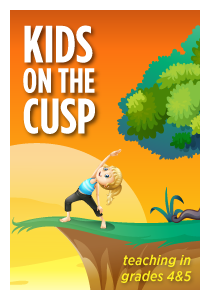 This is a post about about how our lessons sometimes begin to weave themselves, about character development and Wonder and the things that children hear.
This is a post about about how our lessons sometimes begin to weave themselves, about character development and Wonder and the things that children hear.
by Mary Tarashuk
“Students can sense sincerity. They know when we care…when we’re prepared…when they matter.”
A man named Don Shalvey wrote this. I don’t know Mr. Shalvey. I’ve never met him, but I feel like he’d be okay with my calling him Don.
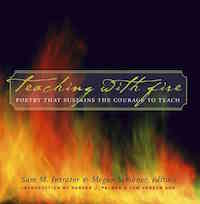
It was written by Stephen Sondheim, master composer and lyricist, and it comes from his magical 1980s musical Into the Woods, later a multiple Oscar-nominated Disney movie. It’s a story that could work well in a fairy tale unit using these study guides from Theatre Works and Orlando-UCF Shakespeare Festival.
Here’s an excerpt from one of the songs:
Children Will Listen
Careful the things you say,
Children will listen.
Careful the things you do,
Children will see.
And learn.
Children may not obey,
But children will listen.
Children will look to you
For which way to turn,
To learn what to be.
Careful before you say,
“Listen to me.”
Children will listen…
It is only when I feel I know my learners that uncomfortable topics can be discussed, and valuable wisdoms can be learned, and I am acutely aware that children are listening. They are listening to their teachers.
What Julian had to tell us
Last week, we wrapped up a two-week mini-unit, after revisiting the 2012 novel Wonder by R.J. Palacio by reading a new chapter!
In mid-2014, an 86-page Wonder “companion story” was published – The Julian Chapter – written in first person perspective by the story’s antagonist Julian Albans. Reading Julian’s version of events gave my students a very different look at the story and reshaped our reactions to it.
Julian torments our protagonist in the original book, also told in first person perspective by seven of the story’s other characters. Each character has flaws. Each character makes mistakes.
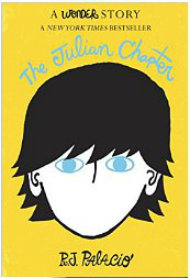
The Julian Chapter gave us a chance to explore some different feelings about him, and to make some text-to-life connections. We started finding a little empathy and understanding of mistakes and bad decisions we all can make.
The powerful impact of post-its
This mini-unit had multiple objectives. We were starting a New Year. We needed to begin focusing (more overtly) on developing a Character Counts piece within our grade level, to present at a school-wide Kindness Assembly in the spring.
In addition, we were setting aside our focus on our non-fiction reading for awhile and preparing to begin our unit on historical fiction. Conveniently, part of Julian’s story takes us back to WW II.
As a culminating piece to our Wonder unit, and in an to attempt to simultaneously launch our school-wide citizenship theme for 2015 and transition into the genre of historical fiction, we completed an activity that met some other, very personal objectives.
Bullyproof Your Classroom with Brown Paper Bags is an article I found here at MiddleWeb while clicking around our site. It was written by Mackenzie Grate, and it is a creative and daring way to teach a valuable message, through personal experience.
This message is transmitted through the eyes of our peers and is written on simple sticky notes. Sometimes the simple tools are the ones that work best. Gathering data on other people’s perspectives can help us gain insight into ourselves.
Grate’s students, sixth graders, are in a different place in their development than my fourth grade kids, but any activity can be differentiated to fit the learner. Differentiation means knowing your kids. This takes time.
“Open and honest reporting”
At this point in the year, I know my kids pretty well. I have made observations on their interactions with each other. The component in Mackenzie’s activity that was somewhat out of my control was the “open, honest reporting” of harms done and niceties noticed. With the fourth grade mindset in mind, I tried to give very clear directions about content, making sure to offer several examples of my own “post-it notes” in life.
My students are nine and ten. They are very thoughtful, very often, but they can be quite mean to each other as well, just like some of the characters in Wonder. A classroom is just a micro-mirror of the real world, with all its personalities and cause and effect relationships.
First we wrote the post-it messages
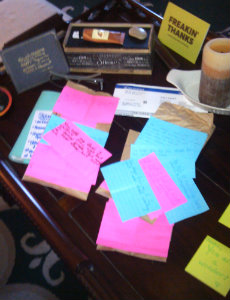
Each learner wrote his or her name on a brown paper lunch bag and gave it to me to place on a small table at the front of the room.
As the kids shared their experiences on those post-its, I circulated the room, peeking at their “facts.” As each student finished reporting, the “evidence” was folded in half, the name of its impending recipient written on top. They pushed each to the side of their desk, indicating that it was ready to be collected. I deposited the messages into each child’s bag (perhaps one or two may have been lost during this process).
Then we read them
Once the writing was done, each child was given his or her bag, and asked to find a quiet corner to sit in. With their reading notebooks in hand, I asked them to pay attention, and to write down what they learned when they opened their bag. I asked them to explain what wisdoms came to mind as they read different perspectives on their behaviors.
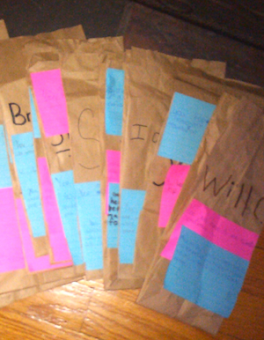
Most of the kids, thankfully, were the recipients of both pink and blue “evidence.” The blue revealed how their actions were perceived by others in a positive light. The pink “evidence” pointed out some of the negative ways that their actions impacted others, information about how their choices had affected other people.
It’s a tough lesson, tougher for some than others. It was also a very valuable lesson, for me and for my students.
During our wrap-up discussion, I shared a few insights into how I’d resolved some of the “pink post-its” in my life. I told them that it was really hard to look at my mistakes sometimes, but that doing it gives me a chance to change my choices, to look at other perspectives…and maybe even change my own.
They were very quiet on the whole during our wrap-up on the rug. They needed time to let what they had read sink in a bit.
Weighing pink and blue, the next morning
The following morning, after each child had a little time to pause, I used the post-it activity and Palacio’s book, Wonder, to give my writers the chance to express themselves again, after they’d had some time to marinate in the experience.
On each desk was a response prompt that I’d written the night before. On the interactive white board, in large, bold letters, was a quote from the book Wonder, a fictional precept for life, written by Julian, our not-so-antagonist-anymore character from this amazing novel. He wrote:
“Sometimes it’s good to start over.” ~Julian Albans
It’s the same precept written by Julian at the end of the original version of Wonder, but now we have much more insight into its true meaning.
Simple tools produce big messages
Post-its can be used as simple tools to look for the big messages, insightful wisdoms, and essential questions we need to ask ourselves.
In my classroom, there have been lessons learned and precepts formed. My job is to model this, as best I can, and to keep looking at my own pink and blue experiences. That’s my definition of being a life-long learner.
I get a much more accurate assessment of my student’s critical thinking skills when they write about a topic they feel passionate and personal about. And boy, did they!
Here are some of the precepts we found hidden in our own writing:
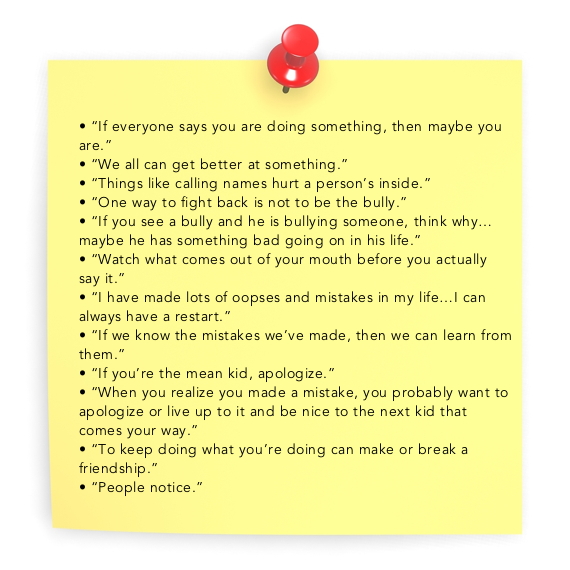


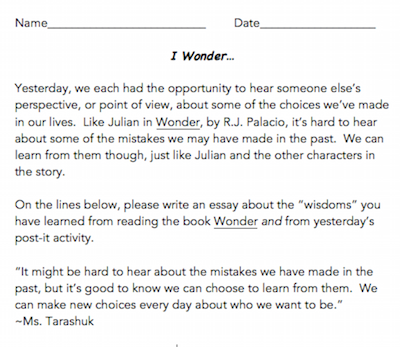




































What a wonderful exercise, and from one that every age can learn!
Thank you, Leslie!…Here’s a neat follow-up…The day after this activity, I had two visitors come to school early to ask if they could have some blue Post-its to put in a classmate’s desk…They wanted to make sure she knew she did “some really nice things too.”…It’s during moments like those that I know it’s all worth it :)